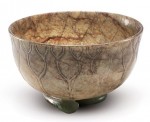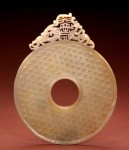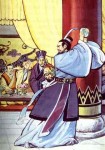Funerary objects of jade
 According to the Historical Records, in 1046 BC the capital city of the Shang was lost to armies of King Wu of the Zhou. Reluctant to be a prisoner of war, King Zhou of the Shang, a most notorious tyrant in Chinese history, set a fire and burned himself to death with a “jade shroud” on. The “shroud”, so to speak, consisted of his most valuable jade pieces strung together, which he wanted to perish together with him.
According to the Historical Records, in 1046 BC the capital city of the Shang was lost to armies of King Wu of the Zhou. Reluctant to be a prisoner of war, King Zhou of the Shang, a most notorious tyrant in Chinese history, set a fire and burned himself to death with a “jade shroud” on. The “shroud”, so to speak, consisted of his most valuable jade pieces strung together, which he wanted to perish together with him.
Far back in prehistory times, it was already believed that jade pieces helped preserve dead bodies. Large quantities of jade artifacts have been excavated from ancient tombs, including even grave clothes made of jade pieces, jade bars in the hands of the dead and jade plugs to gorge the mouth, nose, eyes and ears of the dead with. From tombs of the Liangzhu culture, archeologists have unearthed jade pieces strung together to cover the dead body with. Nearly 100 jade pieces were found on the cover of the coffin when, in 1990, a tomb of the Gao State of the Spring and Autumn period was opened for excavation. The dead body is covered from head to toe with jade pieces. The most remarkable is a piece of textile with small pieces of jade sewn to it, with tiny holes on them to facilitate the sewing.
Things like the “jade veil” and the “jade shroud” that perished along with King Zhou of the Shang were to be developed into “jade grave clothes” – in fact sets of small, polished jade chips sewn together with gold, silver, copper and even silk thread. Two dozen such sets have been unearthed from tombs of princes of the Han Dynasty (206 BC – 220 AD). Each set consists of five “jade cases” separately for the head, the upper part of the body, the lower limbs, the hands and the feet which, put together, assume the shape of a human figure. The jade attire for Prince Liu Sheng of the West Han Dynasty, which was unearthed from his tomb in Mancheng County of Hebei Province, north China, consists of 2,498 jade chips sewn with 1.1 kilograms of gold thread. The prince’s wife shared the tomb with Diflucan Online Pharmacy No Prescription Needed him. She also had jade attire on. Moreover, large quantities of jade ornaments were found in her coffin, the inner walls of the coffin inlaid with as many as 192 jade plates.
After the Han Dynasty, however, use of jade artifacts was no longer limited to aristocrats. It expanded to include rich merchants, landlords and scholars keen to display their social status and wealth. This is due to increased communication between China and areas to its west via the Silk Road, which subsequently boosted the country’s import of raw jade from Central Asia that encompasses what is now Xinjiang Uygur Autonomous Region. As time went by, jade carvings, in fact carvings of not only “soft jade” but also other precious stones like agate and jadeite, became a thriving industry meeting a huge demand from the upper class. Carving techniques and workmanship improved constantly, especially during the period from the Tang Dynasty to the Song and the period when China was under two successive dynasties, the Ming and Qing. People seem to forget that once upon a time, in China’s slavery society, use of jade artifacts was a part of the social estate system prevalent at the time. As ornaments, however, jade artifacts will remain an important aesthetic choice for the Chinese people.
Jade carvings unearthed from the tomb of a Shang dynasty royal concubine
Jade carvings of the Shang-Zhou period feature a much better workmanship  than Liangzhu jade artifacts. Those excavated from the tomb of a Shang Dynasty royal concubine testify to the truth of this assertion.
than Liangzhu jade artifacts. Those excavated from the tomb of a Shang Dynasty royal concubine testify to the truth of this assertion.
The women, Fu Hao, was a concubine of King Wuding of Shang Dynasty, and her tomb in Anyang, Henan Province, was discovered in 1976 by accident. The tomb is in fact a part of the “Yin Ruins” – ruins of the capital city for the Shang Dynasty in its late period some 3,000 years ago.
Of the 1,600 relics unearthed from the tomb, 755 are jade artifacts, including two dozen exquisitely designed animal and bird figures. Let’s see just a few: two hares about to jump, their short tails upward and their long ears against the backs; a tiger with its mouth wide open; an elephant cub with its trunk swaying; and those monkeys that look so cute. The tomb is in fact a zoo of jade animals – real things like elephants, bears, monkeys, rabbits, horses, cattle, sheep, cranes, vultures, parrots, frogs and fish, as well as legendary dragons and phoenixes. There are seven small dragons coiled like alphabet C, inspiring scholars to link them to a large jade dragon of the prehistory Hongshan culture in their study of the continuity and consistency of the Chinese culture.
Two dozen parrots, in fact relieves carved on flat jade pieces, were excavated from the tomb. Two of them share a long tail, their heads arranged in symmetrical order and one side of the tail sharpened like a sword – a perfect combination of artistic value and practical use.
Story of a priceless bi
 In ancient China, what is broadly referred to as bi – round flat jade piece with a hole in the center – could be priceless. Here is the story of a priceless bi, to which the Chinese proverb “worth several cities”(In Chinese Pin Yin, we said it: Jia-Zhi-Lian-Cheng), referring to things that are priceless, is attributed.
In ancient China, what is broadly referred to as bi – round flat jade piece with a hole in the center – could be priceless. Here is the story of a priceless bi, to which the Chinese proverb “worth several cities”(In Chinese Pin Yin, we said it: Jia-Zhi-Lian-Cheng), referring to things that are priceless, is attributed.
The story is told in Historical Records by Sima Qian (145 BC –– ?), China’s first general history presented in a series of biographies. Back in the Warring States period (475 BC – 221 BC), so the story goes, the State of Zhao had an invaluable bi in its possession. On hearing this, the King of the Qin State offered 15 cities in exchange for the jade piece. The King of the Zhao had no trust in the king of the Qin, a notoriously treacherous guy, but was afraid that the Qin would invade his land if he rejected the offer. Lin Xiangru, a court official, volunteered to help crack the hard nut and, on his request, he went to the State of Qin with the bi as envoy of his king.
As he had expected, Lin Xiangru met with the King of the Qin and offered him the bi for a look. When he found that the king of Qin had no intention to honor his promise, Lin cheated him into giving back the bi by saying that there was a flaw in the piece and he would show him where it was. With the bi in his  hands, the man threatened to instantly destroy it before he killed himself by knocking his head on the column against which he was standing. The King of the Qin responded by ordering a map of his state displayed and, pointing at it, he enumerated the 15 cities he would give out in exchange for the bi. Lin Xiangru, however, was not to be taken in, and asked the King of the Qin to fast for five days for an elaborate ceremony to celebrate the change of hands for the bi. Afraid of losing the bi he desperately wanted, the King of the Qin agreed. Immediately after he got to the guesthouse, Lin Xiangru asked a lieutenant to go back with the bi. Here is another Chinese proverb originating from the story: “return the jade intact to the State of Zhao”(In Chinese Pin Yin, we said it: Wan-Bi-Gui-Zhao), meaning return of something to its owner in perfect conditions.
hands, the man threatened to instantly destroy it before he killed himself by knocking his head on the column against which he was standing. The King of the Qin responded by ordering a map of his state displayed and, pointing at it, he enumerated the 15 cities he would give out in exchange for the bi. Lin Xiangru, however, was not to be taken in, and asked the King of the Qin to fast for five days for an elaborate ceremony to celebrate the change of hands for the bi. Afraid of losing the bi he desperately wanted, the King of the Qin agreed. Immediately after he got to the guesthouse, Lin Xiangru asked a lieutenant to go back with the bi. Here is another Chinese proverb originating from the story: “return the jade intact to the State of Zhao”(In Chinese Pin Yin, we said it: Wan-Bi-Gui-Zhao), meaning return of something to its owner in perfect conditions.
Jade artifacts of the Liangzhu culture – 2
 It is a long time since we began taking note of the decorative designs on jade artifacts of the Liangzhu culture –– particularly on those used at sacrificial ceremonies –– that feature animal faces complete with eyes, noses, mouths and other organs. Despite that, discovery in 1986 of the largest cong, or the “king of congs” as it was dubbed later, still took us by surprise. The “king”, which is 8.8 centimeters long and 17.6 centimeters in diameter and weighs 6.5 kilograms, was unearthed from an ancient tomb on Mt. Fanshan, Zhejiang Province. Animal faces in neat groups are engraved on its surface, with the lines recognized as the most elaborate for jade artifacts of the Liangzhu culture. Each group consists of two parts. The upper part is an inverted trapezoid, which bears a broad human face featuring two big eyes, a flat nose, a feather crown and two arms stretching straight and the hands holding the eyes of the image in the lower part. The lower part features a fierce-looking, big-eyed animal face that has a big nose and an oblate mouth. The human head and animal face are cut in relief, and the human arms and animal face, in intaglio. Arrangement of the two parts suggests conquest of a monster by an all-powerful god.
It is a long time since we began taking note of the decorative designs on jade artifacts of the Liangzhu culture –– particularly on those used at sacrificial ceremonies –– that feature animal faces complete with eyes, noses, mouths and other organs. Despite that, discovery in 1986 of the largest cong, or the “king of congs” as it was dubbed later, still took us by surprise. The “king”, which is 8.8 centimeters long and 17.6 centimeters in diameter and weighs 6.5 kilograms, was unearthed from an ancient tomb on Mt. Fanshan, Zhejiang Province. Animal faces in neat groups are engraved on its surface, with the lines recognized as the most elaborate for jade artifacts of the Liangzhu culture. Each group consists of two parts. The upper part is an inverted trapezoid, which bears a broad human face featuring two big eyes, a flat nose, a feather crown and two arms stretching straight and the hands holding the eyes of the image in the lower part. The lower part features a fierce-looking, big-eyed animal face that has a big nose and an oblate mouth. The human head and animal face are cut in relief, and the human arms and animal face, in intaglio. Arrangement of the two parts suggests conquest of a monster by an all-powerful god.
Altogether, 16 such patterns, arranged in symmetrical order, are counted on the “King of all congs”. It may be worthwhile to mention that this kind of “god vs. monster” design is found on most jade artifacts unearthed from Mt. Fanshan. What merits even more attention is that such a pattern is also found on the upper part of a jade ax-spear, the symbol of military authority. Basing themselves on the symbolic weapon, archeologists have concluded that the design could be the emblem of the Liangzhu tribes and that animal face designs on jade artifacts unearthed earlier could be the simplified or distorted version of the emblem.